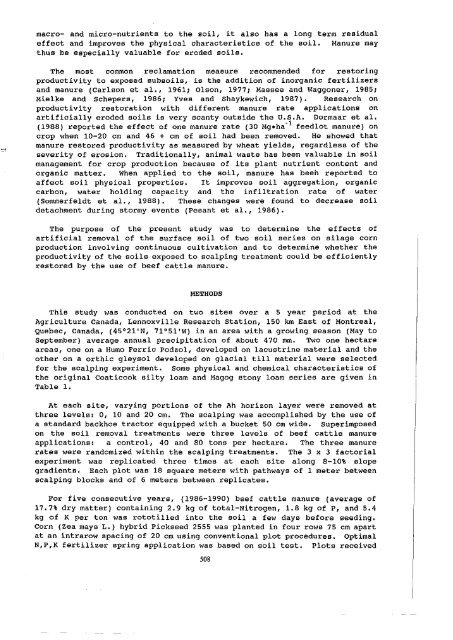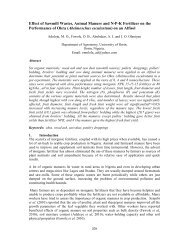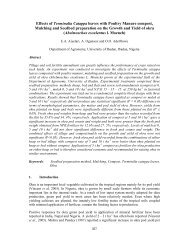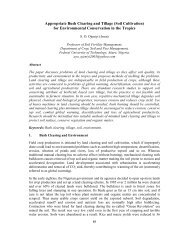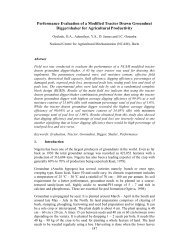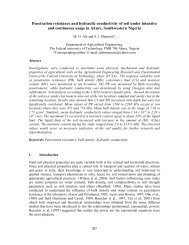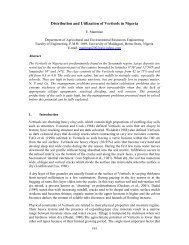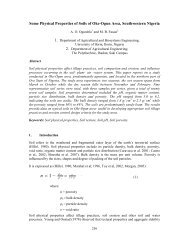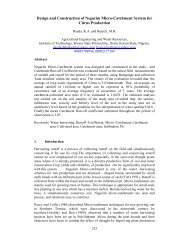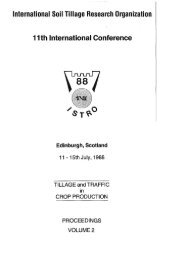- Page 2:
These Proceedings are published by
- Page 5 and 6:
Contents (continued) Subsoil Compac
- Page 8:
Section 1 Soil Related Constraints
- Page 11 and 12:
R ~Ax 1/E R ~ resistance (bar) E =
- Page 13 and 14:
CONCLUSION Under the conditions of
- Page 15 and 16:
Table 1: Variations in some plant p
- Page 17 and 18:
iG. 1.- Interrow penetrometry Resis
- Page 19 and 20:
Q 50 J :- ... 10Q,.L.......J. _____
- Page 21 and 22:
A COMPARISON OF THE EFFECT OF TWO P
- Page 23 and 24:
In the two experiments conducted at
- Page 25 and 26:
R E F E R E N C E S l. Adetunji, S.
- Page 27 and 28:
Table Depth (em) 0-30 30-60 60-90 l
- Page 29 and 30:
Steenhuis, 1990). 2. 5-t----r-...--
- Page 31 and 32:
50 50 a (a) ~ !i "' 0. 0. 2POO 015-
- Page 33 and 34:
MECHANICAL AND CHEMICAL FACTORS LIM
- Page 35 and 36:
The soils were packed to give bulk
- Page 37 and 38:
soil at sowing was no longer presen
- Page 39 and 40:
0.0 0.1 Penetrometer resistance (MP
- Page 41 and 42:
Abstract GYPSUM AND LIME SLOTTING-
- Page 43 and 44:
(Jayawardane and Blackwell 1985). G
- Page 45 and 46:
Control Depth 0·10 m 0·20m Slotte
- Page 47 and 48:
Table 4. Comparison of yields betwe
- Page 49 and 50:
'E' ~ ~ "0 " exchangeable Co [ppm]
- Page 51 and 52:
TILLAGE EFFECTS ON SOIL PROPERTIES
- Page 53 and 54:
Table3 Penetration resistance (kgfc
- Page 55 and 56:
Table 7. Root length density (m/m')
- Page 57 and 58:
REFERENCES Bohm, W ., 1979. Ecologi
- Page 60 and 61:
EFFECTS OF DIFFERENT TILLAGE AND CR
- Page 62 and 63:
this paper. Soil Organic Natter At
- Page 64 and 65:
REFERENCES Agboola, A.A. 1981. The
- Page 66 and 67:
Table II. Tillage and residue manag
- Page 68 and 69:
Table vr. Effect of crop r·esidue
- Page 70 and 71:
EFFECTS OF SOIL MANAGEMENT ON POPUL
- Page 72 and 73:
to 14 days, a second t i 11 age is
- Page 74 and 75:
FHw si gni ·F i cant r·esponses i
- Page 76 and 77:
Blevins, R.L., Thomas, G.W., S~ith,
- Page 79 and 80:
EFFECT OF TILLAGE AND COVER CROP ON
- Page 81 and 82:
leaf stages, but these differences
- Page 83 and 84:
surface soil of N treated plots det
- Page 85 and 86:
Moschler, w.w., Shear, G.M., Marten
- Page 87 and 88:
TABLE 2. Effect of winter legume on
- Page 89 and 90:
PLANT NUTRIENT DISTRIBUTION AND UPT
- Page 91 and 92:
maintain sufficient root growth for
- Page 93 and 94:
agricultural soils can be accelerat
- Page 95 and 96:
steps are those which m1n1m1ze cont
- Page 97 and 98:
Eckert, D.J. 1991. Chemical attribu
- Page 99 and 100:
THE VARIATION IN NITROGEN ECONOMY U
- Page 101 and 102:
Grain and Immobilization 68 Inorgan
- Page 103 and 104:
ploughed (Fig.2). More nitrogen ret
- Page 105 and 106:
GOSS, M,J, 1 HOWSE, K.R. 1 COLBOURN
- Page 107 and 108:
Initial residue quality also plays
- Page 109 and 110:
ate as decomposition proceeds was p
- Page 111 and 112:
Table 1. Initial crop residue chara
- Page 113 and 114:
Table 3. Nitrogen mineralization/im
- Page 115 and 116:
0 ~ ,_..,_ ~ ............ 150 (.!)
- Page 117 and 118:
Fig. 1 Experimental wind-gage stati
- Page 119 and 120:
~ Table 1. Humus and total nitrogen
- Page 121 and 122:
Readily available phosphorus conten
- Page 123 and 124:
116
- Page 125 and 126:
118
- Page 127 and 128:
esearch is the measurement of soil
- Page 129 and 130:
at different depths. The tillage op
- Page 131 and 132:
REFERENCES Agro-ecological Regions
- Page 133 and 134:
Table 3. Comparison of bulk density
- Page 135 and 136:
PAKISTAN AGRO ECOLOGICAL REGIONS SC
- Page 137 and 138:
attention, therefore, needs to be p
- Page 139 and 140:
4. Results and Discussion 4.1 Soil
- Page 141 and 142:
Table 3(a) : Variation of Soil cone
- Page 143 and 144:
~80 ~ " '""' 0 :II ~0 Fig .1: Effec
- Page 145 and 146:
Letters a d denote significance at
- Page 147 and 148:
Jackson, I.J., 1989. Climate, Water
- Page 149 and 150:
MATERIALS AND M~THODS Two experimen
- Page 151 and 152:
Table II: Effect of preclearing til
- Page 153 and 154:
REFERENCE:S Aina P,O,, Fapohunda 1
- Page 155 and 156:
Lack of rains and poor development
- Page 157 and 158:
measures of the three replications
- Page 159 and 160:
.. ::j'"\. //--. ~ '\ I pta 'v lo30
- Page 161 and 162:
6. Cutino, R. y M. Morales (1978).
- Page 163 and 164:
(D (/JCI..AY S ll.T SAND TEXTURAl.
- Page 165 and 166:
::;; ~ (,) ~ j 1.4 BULK DENSITY lS-
- Page 167 and 168:
STRENGTH PROPERTIES AND AGE-HARDENI
- Page 169 and 170:
particle surface towards the region
- Page 171 and 172:
The cohesion C is called the appare
- Page 173 and 174:
and the true cohesion C' in tirre o
- Page 175 and 176:
maximum Sl in the test series U10-3
- Page 177 and 178:
THE INFLUENCE OF THE WAY OF SOILS U
- Page 179 and 180:
Basic physical properties including
- Page 181 and 182:
Soil Utilization Genetic Horizons D
- Page 183 and 184:
SOIL FRACTURE UNDER PLASTIC CONDITI
- Page 185 and 186:
Table.1 The mechanical propertie~ o
- Page 187 and 188:
M.C. =50% Force (N) 40 ~gu 30 20 10
- Page 189 and 190:
2 3 4 5 6 1. Hydraulic motor 2. Too
- Page 191 and 192:
Tangential force(N) 400 300 200 •
- Page 193 and 194:
APPLICATION OF TDR-MINIPROBES AND M
- Page 195 and 196:
~-~~~-~~~--- of TDR) will be given
- Page 197 and 198:
700 600 (ij' 0... 500 E. (ij "" c Q
- Page 199 and 200:
101 • E horizon • ~ 0 'o * E .
- Page 201 and 202:
INFLUENCE OF THE.SHEAR PARAMETERS:
- Page 203 and 204:
RESULTS .., 0 'l:l f "" ~ 1.50 1.00
- Page 205 and 206:
- bulk density air capacity availab
- Page 207 and 208:
Table 3: Angle of internal friction
- Page 209 and 210:
Table 4: Mean single aggregate stre
- Page 211 and 212:
STRUCTURE EFFECT ON STRENGTH AND ST
- Page 213 and 214:
5) the bulk density, pore size dist
- Page 215 and 216:
a second), while those differences
- Page 217 and 218:
' ' ' ' ' ·.. ·. wheel~fro~t rear
- Page 219 and 220:
slow (;:a0.83mls) fast {=2.18mls) \
- Page 221 and 222:
For arable soils Eq. [1] becomes [
- Page 223 and 224:
From fig. 7 it can also be derived
- Page 225 and 226:
physical properties in an ameliorat
- Page 227 and 228:
220
- Page 229 and 230:
The soil consists of well-decompose
- Page 231 and 232:
on arable soil. The weight of the t
- Page 233 and 234:
0 PENETRATION RESISTANCE ( k Po) 60
- Page 235 and 236:
WATER CONTENT ( ml ,.-3) 00 r------
- Page 237 and 238:
three different tillage treatments
- Page 239 and 240:
3.4 Plant Height The progressive he
- Page 241 and 242:
L---[ ..._____! !~.--- 0 -----l. I
- Page 243 and 244:
MOISTURE CONTENT (%) 0 '\ ~ 11 1~ 1
- Page 245 and 246:
THE INFLUENCE OF TRACTOR TRAFFIC ON
- Page 247 and 248:
after compaction was 1,40 Mgm- 3 in
- Page 249 and 250:
the nodulating micro-organisms (Fol
- Page 251 and 252:
REfERENCES ASAE 1 1984. Am. Soc. Ag
- Page 253 and 254:
Table 1. Mean values 1 of dry bulk
- Page 255 and 256:
The objective of this report is to
- Page 257 and 258:
TABLE II Effect of wheel traffic ap
- Page 259 and 260:
REFERENCES Bennie, A.T.P. and Botha
- Page 261 and 262:
METHODS Layout of the experiment In
- Page 263 and 264:
in this layer, within blocks A, B a
- Page 265 and 266:
TABLE 3 Penetration resistance (MPa
- Page 267 and 268:
00 O£PTH (CIJ) SPRING WHEAT 20 40
- Page 269 and 270:
(4) On fine-textured soil (block D)
- Page 271 and 272:
Table 1: Average tyre-soil contact
- Page 273 and 274:
Potatoes and onions were graded and
- Page 275 and 276:
seedbed preparation harvest of root
- Page 277 and 278:
pressure and Zero-traffic for potat
- Page 279 and 280:
SUBSEQUENT EFFECT OF INTENSIVE SOIL
- Page 281 and 282:
tractor. On the plot compacted with
- Page 283 and 284:
REFERENCES Blackwell, P.S., Graham,
- Page 285 and 286:
Table 1. Soli type (USDA Soli Taxon
- Page 287 and 288:
Notice that the soil cohesion estim
- Page 289 and 290:
120 100 0 100 80 ® 60 80 40 60 20
- Page 291 and 292:
284
- Page 293 and 294:
286
- Page 295 and 296:
previously been considered a viable
- Page 297 and 298:
Table 1. Crop establishment and yie
- Page 299 and 300:
Table 2. Crop establishment and yie
- Page 301 and 302:
Table 3. Crop establishment and yie
- Page 303 and 304:
The Cross-Slot® opener (Baker and
- Page 305 and 306:
Appendix I 1 Trial sites, locations
- Page 307 and 308:
Angle of Underside Clearance (AUC}
- Page 309 and 310:
THE TEST SITES The tests were condu
- Page 311 and 312:
2200 1200 2000 ~ 1000 3 ..-.1800 80
- Page 313 and 314:
TILLAGE TEST TRACK -10 2200 2000 ..
- Page 315 and 316:
CONCLUSIONS The results of all the
- Page 317 and 318:
explosives would have double impuls
- Page 319 and 320:
in Fig,1. Typical soil sections aft
- Page 321 and 322:
l =coefficient of charging density~
- Page 323 and 324:
l"'t .• = 0.7 m. J..z" can be obt
- Page 325 and 326:
RESEARCH ON REDUCING THE SLIPPING R
- Page 327 and 328:
Table l,The table of the mechanical
- Page 329 and 330:
The higher the twigs are,the less t
- Page 331 and 332:
F) ~e influence of twigs to the mom
- Page 333 and 334:
:) When the sliding speed is in the
- Page 335 and 336:
Sampling and measurements Particle
- Page 337 and 338:
0 ,----,---.---'--.----.----,.--- A
- Page 339 and 340:
REFERENCES Bird, M., 1985. Seedbed
- Page 341 and 342:
334
- Page 343 and 344:
Table 1. Tillage treatments imposed
- Page 345 and 346:
eKJ 1400 ..J ..J ~ z -~ let CORN I
- Page 347 and 348:
Subsoiling increased grain yield fo
- Page 349 and 350:
CONCLUSIONS Based on this study the
- Page 351 and 352:
EFFECT OF TILLAGE METHODS ON CORN P
- Page 353 and 354:
emergence. Phosphorus and Potassium
- Page 355 and 356:
Table 2. Partial analysis of corn p
- Page 357 and 358:
tillage plots v1as comparable to yi
- Page 359 and 360:
LAND PREPARATION TECHNIQUES IN SOUT
- Page 361 and 362:
TABLE 1 CLIMATE ZONES AND CROPS GRO
- Page 363 and 364:
such as taro/dalo, after the soil h
- Page 365 and 366:
Plantation crops dominate the regio
- Page 367 and 368:
Atoll agriculture is important in t
- Page 369 and 370:
For ISTRO 1991 CONTROLLED TRAFFIC A
- Page 371 and 372:
Results and Discussion Seedbed and
- Page 373 and 374:
The reduced number of operations fo
- Page 375 and 376:
40 ~ Cl 0 N ~ t-- z w t-- z 0 u 0,:
- Page 377 and 378:
Fig.' 5. Cone index profiles (kPa)
- Page 379 and 380:
commonly used by farmers in inland
- Page 381 and 382:
On 22 December 1988 (P
- Page 383 and 384:
locations; L/SB - between sampling
- Page 385 and 386:
Table 2. Effect of seedbed preparat
- Page 387 and 388:
~ 01 c: += § Ci ..... Q) ;::: 0 0
- Page 389 and 390:
z·r-------------------------------
- Page 391 and 392:
TILLAGE AND CROPPING SYSTEMS EFFECT
- Page 393 and 394:
tillage methods. (a) maize (Zea may
- Page 395 and 396:
TABLE 3. Number of leaves per plant
- Page 397 and 398:
TABLE 7, Maize grain yield in the f
- Page 399 and 400:
ACKNOWLEDGEMENTS These experiments
- Page 401 and 402:
SEEDBED PREPARATION AND lvEED CONTR
- Page 403 and 404:
appears that for gliricidia.the hei
- Page 405 and 406:
2 November 1984. Ababa, Ethiopia. I
- Page 407 and 408:
Table 2. Effect of method of seedbe
- Page 409 and 410:
EFFECTS OF TYPE OF SEEDBED AND SESB
- Page 411 and 412:
The four placement methods above ap
- Page 413 and 414:
application (direct effect) and yie
- Page 415 and 416:
Table 3. Effects of sesbania sesban
- Page 417 and 418:
ADAPTIVE NO-TILL TIEI).RJDGING TRIA
- Page 419 and 420:
September 1990 and November 1990 ne
- Page 421 and 422:
0 '+c 0 0 0:: 0 '" (c, 0 " c •'D
- Page 423 and 424:
REFERENCES 1) G. L. Chavunduka. "So
- Page 425 and 426:
production-protection systems suita
- Page 427 and 428:
at about one meter intervals along
- Page 429 and 430:
The figures for hand hoeing, instal
- Page 431 and 432:
een so vigorous that by the time th
- Page 433 and 434:
Gotora, P. (1991): Adaptive no-till
- Page 435 and 436:
Grain was harvested using a small p
- Page 437 and 438:
Table 1 Effect of fallow management
- Page 439 and 440:
Table 3 Effect of fallow management
- Page 441 and 442:
of Touchton et al. (1982) and Touch
- Page 443 and 444:
SOIL NITROGEN In 1988, results for
- Page 445 and 446:
Lamb, J.A., G.A. Peterson, and C.R.
- Page 447 and 448:
Table2 Soil N, at 0-15cm depth, fro
- Page 449 and 450:
10 r-----;----+---'--+------t GRIFF
- Page 451 and 452:
lasting several years in order to d
- Page 453 and 454:
Table 2. Basic soil tillage (A) Mai
- Page 455 and 456:
The effects that the fertilization
- Page 457 and 458:
Table 5. Soyabean grain yield (t/ha
- Page 459 and 460:
that the best results were obtained
- Page 461 and 462:
S F SOtiRCE 0 WEED INFESTATION PLAN
- Page 463 and 464: grains - row crop (like cotton) - p
- Page 465 and 466: In modern agriculture with a high c
- Page 467 and 468: speaking there are four methods con
- Page 469 and 470: Fig, 8: Weeds after weeding brush i
- Page 471 and 472: and infiltration rate (irrigation)
- Page 473 and 474: 5. SUMMARY Weed control as a very c
- Page 475 and 476: [11] Kohlenberg, F.-H.: Untersuchun
- Page 477 and 478: 470
- Page 479 and 480: 2.1.1 CLIMATE The main characterist
- Page 481 and 482: As it can be seen, ERa varies consi
- Page 483 and 484: Morgan R.P.C. (1986): Soil erosion
- Page 485 and 486: "'" ). ___...,. ral ..otl _,.,.., n
- Page 487 and 488: G.raph No 1 Rainfall .Jiatribution
- Page 489 and 490: The tillage treatments imposed on l
- Page 491 and 492: No Tillage (NT) Direct Drill (DD) 3
- Page 493 and 494: No Tillage (NT) Direct Drill (DO) f
- Page 495 and 496: aindrop impac~, surface roughness a
- Page 497 and 498: l Tahl.e 1 - Sioopl.e reg>:essi.on
- Page 499 and 500: Table 2 - cempa.riaon of 1980 and 1
- Page 501 and 502: At Cowra, pH was significantly lowe
- Page 503 and 504: REFERENCES Allison, L.E., 1965. "Or
- Page 505 and 506: Laflen, J.M., Baker, J.L., Hartwing
- Page 507 and 508: Methods For the interrill erosion s
- Page 509 and 510: erosion from the rain-fed discharge
- Page 511 and 512: Eckert, D.J. 1987b. Evaluation of r
- Page 513: 2 .. 0 ~---------------------------
- Page 517 and 518: RESULTS Crop productivity The effec
- Page 519 and 520: Table 2. Effect of scalping treatme
- Page 521 and 522: SILAGE CORN DRY MATTER (1/ha) 14 CO
- Page 523 and 524: in the humus-accumulative horizon o
- Page 525 and 526: 518
- Page 527 and 528: 520
- Page 529 and 530: in farmers fields under different m
- Page 531 and 532: Constraints to Food Production in t
- Page 533 and 534: TECHNICAL AND ECONOMICAL FEASIBILIT
- Page 535 and 536: the cotton areas. The used implemen
- Page 537 and 538: Developments in chemical weed contr
- Page 539 and 540: Table 2. Annual total scheme requir
- Page 541 and 542: Table 4 Ca.lculRI.ed fuel and lubri
- Page 543 and 544: SOCIO ECONOMIC CONSIDERATIONS IN TI
- Page 545 and 546: fertilizer d~ill and ridger/ridge s
- Page 547 and 548: arid (49,6%) and arid zone (75,57%)
- Page 549 and 550: Table-1 Adoption of preparatory til
- Page 551 and 552: 1 2 3 5 EDUCATION Illiterate n 1 =
- Page 553 and 554: ATTITUDES TOWARD AND PARTICIPATION
- Page 555 and 556: enrolled in the program. Property o
- Page 557 and 558: elated to: 1) knowledge of conserva
- Page 559 and 560: conservation programs designed to r
- Page 561 and 562: Footnotes 1. Cross compliance means
- Page 563 and 564: Hatley, Michael L., R. Terry Ervin
- Page 565 and 566:
ECONOMIC PERSPECTIVES ON EROSION AN
- Page 567 and 568:
Downstream benefits, by contrast, a
- Page 569 and 570:
thin topsoil layers, or is more exp
- Page 571 and 572:
Table 2. Region Annual Total Damage
- Page 573 and 574:
Developing countries have little ex
- Page 575 and 576:
Larson, E. w., F. J. Pierce, and R.
- Page 577 and 578:
570
- Page 579 and 580:
Methods Experiment 1 Root growth re
- Page 581 and 582:
comparison between Eavis's (1967) r
- Page 583 and 584:
Fig. 3. Cumulativa root contact•
- Page 585 and 586:
References Bengough, A.G. and Mulli
- Page 587 and 588:
allocated to groups according to an
- Page 589 and 590:
Table 2. CULTSA VB at a glance. 1).
- Page 591 and 592:
Recommendation 4 (R4), The cultivat
- Page 593 and 594:
586
- Page 595 and 596:
588
- Page 597 and 598:
Other studies, however, have shown
- Page 599 and 600:
Maximum soil temperature within the
- Page 601 and 602:
Table 1: Maize grain yields (Mg/ha)
- Page 603 and 604:
.. / · .. , :r ;lj.J,
- Page 605 and 606:
TILLAGE AND MULCH EFFECTS ON GROWTH
- Page 607 and 608:
-- without any fertilizer (F 0 ) co
- Page 609 and 610:
TABLE 2. Maize grain yield as affec
- Page 611 and 612:
TABLE 5. Effects of fertility and m
- Page 613 and 614:
REFERENCES Aina, P.o., 1979, Soil c
- Page 615 and 616:
the soil and help improve soil stru
- Page 617 and 618:
esistance average value of about 35
- Page 619 and 620:
highest inTI treatment (0,52 t/ha a
- Page 621 and 622:
Table 7, Economy of okra production
- Page 623 and 624:
MULCH RATE EFFECTS ON MAIZE GROWTH
- Page 625 and 626:
were measured at harvest. The Oxyge
- Page 627 and 628:
TABLE 2. Analysis of variance table
- Page 629 and 630:
Oxygen Diffusion Rate (ODR): The OD
- Page 631 and 632:
REFERENCES Bond, J.S. and Willis, W
- Page 633 and 634:
FERTILIZATION AND ROTATION OF THE S
- Page 635 and 636:
microbiology scientists to increase
- Page 637 and 638:
crop residues added to the soil obt
- Page 639 and 640:
ACKNOWLEDGEMENTS The authors expres
- Page 641 and 642:
Torres, E. & Neumaier, N., 1988. Po
- Page 643 and 644:
TABLE 2. Fertilizer recommendations
- Page 645 and 646:
TABLE 4. Farm division in four plot
- Page 647 and 648:
Table 1. Cultivation treatments for
- Page 649 and 650:
soil tillage or under discharrowing
- Page 651 and 652:
Table 5 Effect of soil til~age on b
- Page 653 and 654:
Komljenovic, I. (1990): Mogucnost p
- Page 655 and 656:
RESULTS OF A 10-YEAR REDUCED SOIL T
- Page 657 and 658:
differences among tillage methods w
- Page 659 and 660:
Table 1 - Results of 10 -year long
- Page 661 and 662:
THE EFFECT OF SURFACE RESIDUES AND
- Page 663 and 664:
ow The IIJbterranean clover was sow
- Page 665 and 666:
Table 2. The above ground vegetativ
- Page 667 and 668:
The large number of earthworms in t
- Page 669 and 670:
Russell, J.S. and Isbell, R.F. Univ
- Page 671 and 672:
Section 11 Postscript 664
- Page 673 and 674:
tractor draw tillage tools over the
- Page 675 and 676:
Table 3(a) Treatment Mean> for Meas
- Page 677 and 678:
Table 4: Summary of Statistical Ana
- Page 679 and 680:
Soil Properties The depth of soil d
- Page 681 and 682:
674
- Page 683 and 684:
INTRODUCTION In Nigeria, mound maki
- Page 685 and 686:
METHODS AND MATERIALS 4 The tillage
- Page 687 and 688:
RESULTS AND DISCUSSION 6 The advant
- Page 689 and 690:
REFERENCES Ijioma, C.I. 1987. Hardn
- Page 691 and 692:
FIG. I TYPf I MACHINE FIG· 2 TYPE
- Page 693 and 694:
~ li r I .-U r t"' ~e. A ., · n ~~


